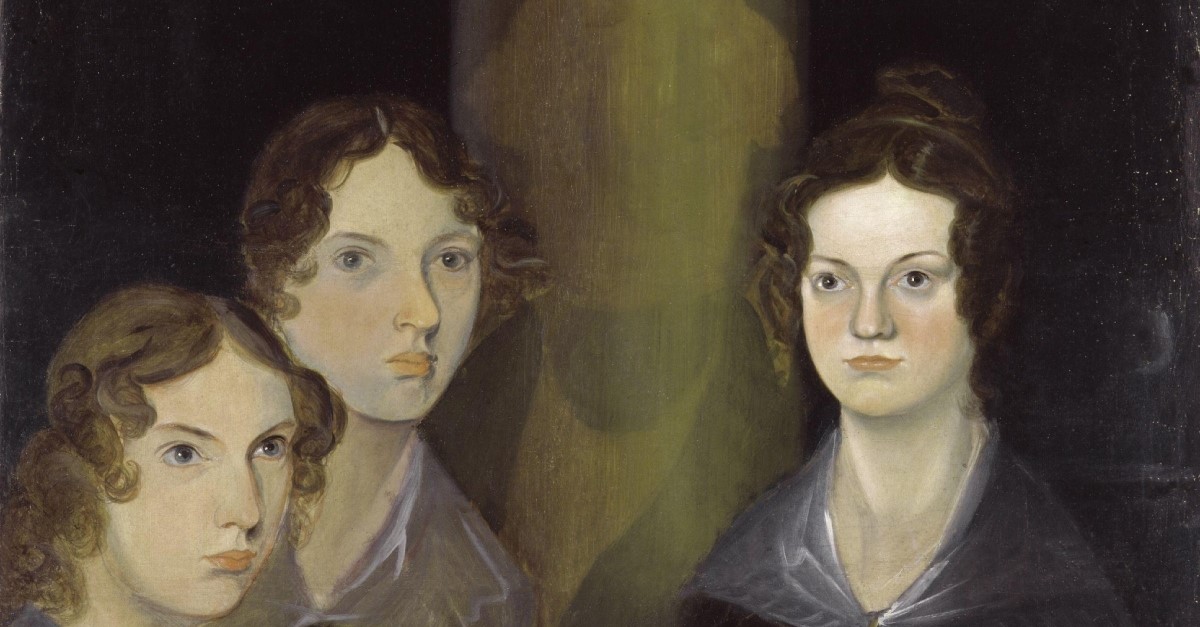The Brontë Sisters were dedicated to the craft of writing. They wrote iconic works such as Wuthering Heights, Jane Eyre, Agnes Grey, Vilette, The Professor, Shirley, and The Tenant of Wildfell Hall. They left behind an incredible literary legacy that has inspired many different writers around the world—such as Virginia Woolf, C.S. Lewis, and Madeleine L’Engle.
What makes the Brontë Sisters’ books classics, and what can Christians learn from their literary legacy?
Who Were the Brontë Sisters?
Anne, Charlotte, and Emily Brontë were born in Thornton, England. Charlotte was born in 1816, Emily was born in 1818, and Anne was born in 1820. Their brother, Branwell, was born in 1817.
Their father, Patrick Brontë, was born in Northern Ireland in 1777 as Patrick Brunty. Patrick changed his last name from Brunty to Brontë in 1802. Patrick was raised doing different manual labor jobs, from blacksmithing to weaving, and was also a headmaster at Glascar school in Northern Ireland. Patrick eventually emigrated to England to pursue his vocational calling as a minister. He underwent theological education at King’s College, Cambridge University, became an ordained parson in 1807, and was offered a job as the rector at Haworth in 1820. Patrick lost his wife, Maria Brontë, to cancer in 1821. Patrick died in 1861 at 84 years old.
While early promise as a painter and writer suggested that Branwell would be the family’s famous artist, alcoholism and other issues meant Branwell struggled to find work. He passed away in 1848 at 31 years old. Today, he is most famous for making a painting depicting himself with his sisters, then deciding to paint himself out of the portrait.

While Branwell’s artistic career floundered, his sisters found success. In 1846, they self-published a poetry collection, Poems, using pen names (Currer, Ellis and Acton Bell). The next year, each published a novel: Charlotte published Jane Eyre, Emily published Wuthering Heights, and Anne published Agnes Grey.
At the time, women were frowned upon if they published books. The Brontë Sisters challenged this taboo by using pen names, though Charlotte revealed their true names in 1850 after her sisters had passed away. Their determination to get their work into print took a great act of faith. Their dream became a reality through discipline and persistence, and they became literary icons.
The Brontës’ former home at Haworth can still be visited today in Yorkshire, England. The Brontë Society currently owns it and it is now called The Brontë Parsonage Museum. People who visit the Brontë Homeland Drive near Branbridge in Northern Ireland can see the school where Patrick first taught and the church where he preached his first sermon.
Did the Brontë Sisters Include Christian Characters in their Works?
Being raised by an Anglican priest, many important theological themes influenced the Brontë Sisters’ works. Biographers and scholars have written with great insight about their devout Christian faith and how they rejected the fundamentalism that was then dominant in England. The Brontë Sisters took issue with sexism towards women, self-righteous piety, and wealthy social status being a sign that God approved of one. They understood that Jesus of Nazareth offered all humanity redemption, championing the oppressed, broken, and outcast. They also noted Jesus’ humility, recorded in the three first-century synoptic gospels. The Brontë Sisters believed that Jesus’ humility is one of the most important Christian virtues one could imitate in this life.
A good example from the Brontë Sisters’ work of a Christian character is found in Anne Brontë’s Agnes Grey. The minister Edward Weston is portrayed as one who truly practices the virtues of faith, hope, and love, unlike fellow minister Mr. Hatfield, who presents God as a severe judge rather than a loving father in his sermons. Agnes is drawn to Weston as she observes how he treats the poor and sick in the novel. Weston also is no respecter of persons and truly reflects the agape love of Christ in his life. The two marry in the end and find happiness.
What Are Some Christian Themes in the Brontë Sisters’ Work?
In Charlotte Brontë’s novel Jane Eyre, the themes of suffering and faith are immensely important. The book was published in 1847 under the pen name of Currer Bell. In the story, the heroine, Jane, experiences terrible cruelty at the boarding school she attends by the headmaster. This cruelty causes great pain that causes her to reject the idea of an angry Calvinist God. The young Jane sees the toxic theology reflected in how she is treated and concludes that it contradicts the Christian message of agape love.
The suffering Jane experiences—her aunt physically abusing her, losing her friend Helen to tuberculosis, and struggling over never finding someone to love, strengthens her faith in Christ and teaches her fortitude. This virtue of faith mattered deeply to Charlotte in daily life. She lost her mother to an early death, her brother to addiction, and her child. The story ends happily when Jane and Mr. Rochester come to marry and love each other. This ending gives the reader a sense of hope as both characters’ faith is strengthened through their suffering.
Grace is an important Christian theme in Jane Eyre, reflected in Mr. Rochester’s character development. When Jane becomes a governess at Thornfield Hall, she observes the negative demeanor of Mr. Rochester. Throughout the novel, his character changes for the better, and Jane learns of Mr. Rochester’s first wife, Bertha Mason, who succumbed to madness years after marriage. Mr. Rochester keeps Bertha locked up in a particular room in part of the house to keep her safe. Scholars and readers debate whether Mr. Rochester’s action is a morally right choice for his wife’s safety.
Eventually, Bertha escapes, commits suicide, and Thornfield Hall burns to the ground. During this tragedy, Mr. Rochester fails to save Bertha but can save some of the servants. Jane learns of this after she leaves Thornfield Hall after being mistreated by Mr. Rochester and knows that Rochester has undergone quite a dramatic change: he repents of his past sins, including mistreating people. Jane shows him grace, marrying him in the end despite his past. Rochester’s sight is restored after being blinded during the fire of Thornfield Hall. The reader can interpret this miracle as God showing grace to Rochester to truly know what it means to see with the eyes of the heart.
Readers have viewed Wuthering Heights by Emily Brontë as a ghost story, a Gothic novel, a story of vengeance, and a satire on cultural Victorian Christianity. It is a fascinating book that has an explicit Christian theme of forgiveness. Though Heathcliff and Catherine experienced romantic love, Catherine ultimately chooses Edward Linton over Heathcliff because of his kindness and stability. When Catherine is dying, she asks Heathcliff to forgive her, and though he is reluctant, he does so out of love for her. This theme of forgiveness shown in the two characters is central to Christianity. Christ came to rescue humankind even though we did not deserve it and offers forgiveness, freedom, joy, and eternal life to anyone willing to repent.
In Anne’s novel Agnes Grey, an important Christian theme is perseverance. Agnes experiences psychological abuse through working as a governess. The family who employs her and the children she seeks to nurture are patronizing, unthankful, and treat her as inferior. This abuse causes Agnes to see the human heart’s dark side and feel alienated from the world around her. As difficult as her sufferings are, Agnes still preserves with great courage. By doing this, she finds joy in her trials and marries the minister, Edward Weston, at the end of the story. This example of a literary character correlates to St. Paul’s writing about faith being cultivated through perseverance in Romans chapter 5.
Great Guides to Learning about Christian Themes in the Brontë Sisters’ Work
Below are some great resources for learning more about the Brontë Sisters’ faith, personal lives, and literary influences.
The Brontë Sister Cabinet: Three Lives In Nine Objects by Deborah Lutz
The Brontë Sisters: The Brief Lives of Charlotte, Emily, and Anne by Katherine Reef
Walking The Invisible: A Literary Guide through the Walks and Nature of the Brontë Sisters, Authors of Jane Eyre and Wuthering Heights, and Their Beloved Yorkshire by Michael Stewart
Charlotte Brontë: A Fiery Heart by Claire Harman
The Brontë Sisters: Life, Loss and Literature (Trailblazing Women) by Catherine Rayner
A Chainless Soul: A Life of Emily Brontë by Katherine Frank
The Brontës by Juliet Barker
The Brontë Myth by Lucasta Miller
The Brontës in Ireland; Or, Facts Stranger than Fiction by William Wright
Best Books by the Brontë Sisters to Start With
Jane Eyre by Charlotte Brontë
The Professor by Charlotte Brontë
Shirley by Charlotte Brontë
Villette by Charlotte Brontë
Wuthering Heights by Emily Brontë
The Complete Poems of Emily Brontë
Agnes Grey by Anne Brontë
The Tenant of Wildfell Hall by Anne Brontë
The Complete Poems of Anne Brontë
Photo Credit: Philip Halling/Wikimedia Commons
Justin Wiggins is an author who works and lives in the primitive, majestic, beautiful mountains of North Carolina. He graduated with his Bachelor's in English Literature, with a focus on C.S. Lewis studies, from Montreat College in May 2018. His first book was Surprised by Agape, published by Grant Hudson of Clarendon House Publications. His second book, Surprised By Myth, was co-written with Grant Hudson and published in 2021. Many of his recent books (Marty & Irene, Tír na nÓg, Celtic Twilight, Celtic Song, Ragnarok, Celtic Dawn) are published by Steve Cawte of Impspired.
Wiggins has also had poems and other short pieces published by Clarendon House Publications, Sehnsucht: The C.S. Lewis Journal, and Sweetycat Press. Justin has a great zeal for life, work, community, writing, literature, art, pubs, bookstores, coffee shops, and for England, Scotland, and Ireland.
This article is part of our People of Christianity catalog that features the stories, meaning, and significance of well-known people from the Bible and history. Here are some of the most popular articles for knowing important figures in Christianity:
How Did the Apostle Paul Die?
Who are the Nicolaitans in Revelation?
Who Was Deborah in the Bible?
Who Was Moses in the Bible?
King Solomon's Story in the Bible
Who Was Lot's Wife in the Bible?
Who Was Jezebel in the Bible?
Who Was the Prodigal Son?


.jpg)
